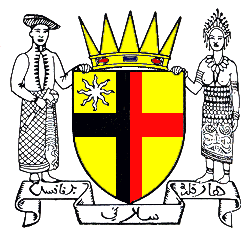SARAWAK
 |
BRIEF HISTORY
The ruling prince: Sri Paduka Duli Yang Maha Mulia Rajah dan Yang di-Pertuan Negara Sarawak, i.e. The Rajah of Sarawak, with the style of His Highness.
The consort of the ruling prince: Sri Paduka Duli Yang Maha Mulia Rajah Ranee, i.e. The Ranee of Sarawak with the style of Her Highness.
The Heir Apparent: Sri Paduka Duli Yang Maha Mulia Rajah Muda, i.e. The Rajah Muda of Sarawak, with the style of His Highness.
Wife of the Heir Apparent: Sri Paduka Duli Yang Maha Mulia Ranee Muda, i.e. The Ranee Muda of Sarawak with the style of Her Highness.
The Heir Presumptive: Sri Paduka Duli Yang Maha Mulia Tuan Muda, i.e. The Tuan Muda of Sarawak, with the style of His Highness.
Wife of the Heir Presumptive: Sri Paduka Duli Yang Maha Mulia Dayang Muda, i.e. The Dayang Muda of Sarawak with the style of Her Highness.
Daughters of the Sovereign: Duli Yang Mulia Dayang (personal name).
* the Rajah, his wife and the Heir Apparent, were granted court rank in England by King George V, immediately after the Indian Princes.
GLOSSARY:
Dayang: lady, title of the daughters of a noble.
Dayang Muda: 'little lady', title of the wife of the Heir Presumptive.
Rajah: Prince, title of the ruler of Sarawak.
Rajah Muda: 'little prince', title of the Heir Apparent.
Rajah Ranee: title of the wife of the Rajah as rendered in Malay.
Ranee: Princess, title of the wife of the ruler of Sarawak.
Ranee Muda: 'little princess', title of the wife of Heir Apparent.
Tuan: lord or master.
Tuan Besar: 'senior lord', third highest title after the Rajah.
Tuan Bongsu: 'youngest lord', fourth most important title after the Rajah.
Tuan Muda: 'little lord', title of the Heir Presumptive.
RULES OF SUCCESSION:
The reigning Rajah could nominate his successor from the family of Rajah Sir James Brooke.
ORDERS AND DECORATIONS:
See link below.
SOURCES:
S. Baring-Gould & C.A. Bampfylde. A History of Sarawak Under its Two White Rajahs, 1839-1908. London. Henry Sotheran. 1909
Nigel Barley. White Rajah: a biography of Sir James Brooke. Little, Brown & Co., London, 2002.
W. Batty-Smith, MBE, FRPSL. Sarawak: The Rajah's Officers 1841-1946. Nigel Batty-Smith, Charnage, Wilts., 1999.
G.E. Brooke. Brooke of Horton in the Cotswolds, with notes on some other Brooke families. Methodist Publishing House, Singapore, 1918.**
Margaret Brooke. Good Morning and Good Night. Constable and Co., London, 1934. ***
Margaret Brooke. My life in Sarawak by the Ranee of Sarawak. Oxford University Press, Singapore, 1986.
Sylvia Leonora (Brett), Lady Brooke. Queen of the Head-Hunters: the autobiography of H.H. The Hon. Sylvia, Lady Brooke, Ranee of Sarawak.
Sidgwick & Jackson, London, 1970.
Burke's Landed Gentry, Burke's Peerage Ltd., London. 1937, 1969.
Burke's Peerage, Baronetage and Knightage, Burke's Peerage Ltd., London, 1959.
Colin N. Crisswell. The End of the Brooke Raj in Sarawak. Kiscadale, Gartmore, Stirlingshire, 1994.
Colin N. Crisswell. Rajah Charles Brooke: Monarch of all he Surveyed. Oxford University Press, Kuala Lumpur, 1978.
Emily Hahn. James Brooke of Sarawak: a biography of Sir James Brooke. Arthur Barker, London, 1953.
Index to Titles (1798-1835), As Recorded in the Alqabnamas or Books of Titles and Forms of Address. National Archives of India, New Delhi, 1980.
Gertrude Le Grand Jacob. The Raja of Sarawak: an account of Sir James Brooke given chiefly through letters and journals. London, 1876.
Robert Payne. The White Rajahs of Sarawak. Oxford University Press, Singapore, 1986.
Cassandra Pybus, The White Rajahs of Sarawak, Dynastic Intrigue and the Forgotten Canadian Heir. Douglas & McIntyre, Vancouver, 1997.
R.H.W. Reece. The Name of Brooke, the End of White Rajah Rule in Sarawak. Oxford University Press, Kuala Lumpur, 1982.
Sir Steven Runciman, The White Rajahs: a history of Sarawak from 1841 to 1946. Cambridge University Press, London, 1960.
Nicholas Tarling. Britain, the Brookes and Brunei. Kuala Lumpur ; London : Oxford University Press, 1971.
Nicholas Tarling. The Burthen, the Risk, and the Glory: a biography of Sir James Brooke. Oxford University Press, Kuala Lumpur, 1982
J.H. Walker. Power and Prowess: the origins of Brooke kingship in Sarawak. Allen & Unwin, Crows Nest, NSW, Australia, 2002.
** Some of the genealogies given in this publication are quite erroneous. The author, a colonial official in Malaya, seems to have been embarrassed by the racial origins of some of his illustrious connections, yet a little too enamoured by their success in public life to leave them out entirely. Consequently, he attributes legitimate lines of descent and relationships to them that are entirely false.
*** In this publication, the Ranee Margaret gives a confused and garbled account of the French and Dutch ancestors of her mother.
SPECIAL ACKNOWLEDGEMENTS:
Jason Brooke, Esq.
Joanna Capon.
Eileen M Pye, Brisbane, Queensland, Australia.
Christopher Quaile.
David Williamson.
Copyright©Christopher Buyers, November 2000 - November 2014